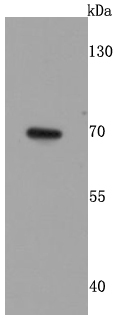There are two forms of glutamic acid decarboxylases (GADs) that are found in the brain: GAD-65 (also known as GAD2) and GAD-67 (also known as GAD1, GAD or SCP). GAD-65 and GAD-67 are members of the group II decarboxylase family of proteins and are responsible for catalyzing the rate limiting step in the production of GABA (g-aminobutyric acid) from L-glutamic acid. Although both GADs are found in the brain, GAD-65 localizes to synaptic vesicle membranes in nerve terminals, while GAD-67 is distributed throughout the cell. GAD-67 is responsible for the basal levels of GABA synthesis. In the case of a heightened demand for GABA in neurotransmission, GAD-65 will transiently activate to assist in GABA production. The loss of GAD-65 is detrimental and can impair GABA neurotransmission, however the loss of GAD-67 is lethal. Due to alternative splicing, two isoforms exist for GAD-67, the predominant GAD-67 form and the minor GAD-25 form. GAD-25 is not expressed in brain but can be found in a variety of endocrine tissues.

